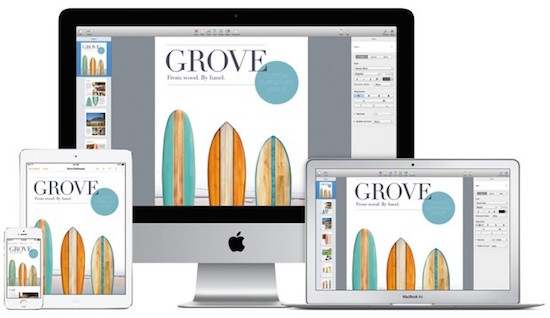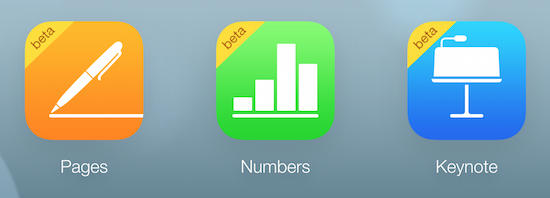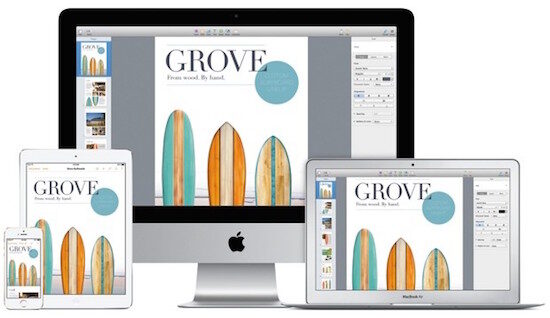
For years, Microsoft Office has been the gold standard for productivity software for business. If you took an inventory of the applications on most computers used in the corporate environment, chances are you’d find some version of Word, Powerpoint, and Excel installed on the majority of hard drives. MS Office has gotten so ubiquitous in fact, that it is installed on more than 85% of business workstations worldwide, making it as dominant in the productivity software space as Window is amongst operating systems. Fortunately, Apple has created a viable alternative to Office in the form of Pages, Numbers, and Keynote, collectively known as iWork. These apps provide most of the same functionality as Microsoft’s software, but with the simplicity and ease of use that we expect from an Apple product. Here’s iWork is the better software solution for Mac users.
Yearly Updates
While Microsoft has failed to update Office for Mac since 2011, Apple has continued to refine its software, offering improved functionality, better performance, and slick new features. As a result, Pages, Keynote, and Numbers have gained a level of parity with their Office counterparts, and in some ways even surpassed them. With yearly updates, iWork continues to improve, and has evolved to meet the times. Over the past few years, Apple has added mobile integration, support for iCloud, and access to web versions of the app. Meanwhile, Microsoft continues to promise an updated version of the Office suite for Mac is coming soon, but there has been no indication of when exactly that will happen.
Price
MS Office for Mac will set you back about $90 for the Home and Student versions, while the business edition costs $150 per user. Mind you, that is for the 2011 edition, which is now well over three years old. When Microsoft releases their next update, it will be for Office 360, their cloud based solution that comes with a $10/month subscription fee. That means, owning Office will cost you $120/year in perpetuity, should you continue to use the product. Cancel your monthly subscription, and all of your software will cease to operate. Apple charges just $19 each for Pages, Numbers, and Keynote. That gives you the flexibility of only purchasing the apps you need, with a total price tag of less than $60 for the entire suite. Better yet, iWork comes pre-installed on all new Mac laptops and desktops, as well as iOS devices. That means, when you buy a new Apple product, you get the software for free.
Cross-Device Functionality
Because there are versions of iWork for both Mac and iOS devices, you can actually create and edit documents on your laptop, iPhone, iPad, or even iPod Touch. And if you happen to be running iOS 8 and OS X Yosemite, the Handoff feature will allow you to start working on a file on one device, and seamlessly continue working on that same document on another. This is incredibly useful for busy businessmen and women who need to be able to stay productive while on the go, without compromising the tools that they have at their disposal.

iCloud Drive
With the introduction of iOS 8 and OS X Yosemite, Apple has also opened access to iCloud Drive, a storage solution that makes sharing documents between devices even easier. If you use any of the iWork applications, you can automatically save your documents to the cloud, and they will be available to open, and edit, on any of your other devices at any time. This is incredibly handy for keeping your important documents up to date, and it can ensure that those files are properly backed-up as well. Microsoft does offer similar capabilities with its One Drive service, but in order to use it, you must also upgrade to the Office 360 suite with the monthly subscription fee. That is, once it actually becomes available for Mac.

iWork for Web
The iWork suite of software isn’t just available for use on your Mac, iPhone, and iPad – it is also available on the web too! Apple has built fully-functioning versions of Pages, Numbers, and Keynote into iCloud, giving us access to the software – as well as all of our files saved to iCloud Drive – from just about any computer that has an Internet connection. While the web versions of the apps remain in Beta at the moment, Apple continues to update them regularly, improving speed and functionality over time. This very handy option means that we have access to productivity software whenever, and wherever, we need it.
Office Compatibility
Apple knows that MS Office is the standard for productivity software across the globe, which is why they have built in compatibility with Microsoft’s file formats. Word, Excel, and Powerpoint documents can be opened – and edited – in iWork, with ease, and all files created in Pages, Numbers, and Keynote can be saved in the proper Office formats as well. This makes sharing files with others who are not using Apple’s software a breeze, and eliminates the worry of knowing whether or not the person you are sharing a file with can actually open it.

Make no mistake, iWork isn’t for everyone. Heavy-duty Excel users could find Numbers lacking in some key features that they rely on heavily, making it difficult to make the change. But Pages is more than capable of holding its own with Word, and Keynote surpasses Powerpoint in many ways. For the vast majority of users, Apple’s productivity apps provide more functionality than they’ll ever need, and when you consider all of the factors listed above, it is easy to make a compelling argument as to why Mac users should choose iWork over Office.
Also Read:
Why You Should Skip the iPad 3
Is Apple Selling Too Many Products?





20 thoughts on “Why Apple’s Productivity Apps Should Replace Microsoft Office for Mac Users”
Can’t tell you how strongly I disagree with this. The way Apple has developed and treated iWork results in a complete disaster for any even medium sized deployments. I work for a school district that *had* mostly settled on iWork for our students and teachers, who were mostly pretty happy with iWork 09.
When Apple updated iWork for better cross-platform compatibility with the iOS versions, we were pretty excited at the collaborative possibilities, but it’s been a disaster for us. Because we have nearly 4000 Macs, we can’t just pull the trigger and upgrade them instantly, services and custom apps need to be tested and issues fixed first. Before we had a chance to do that, users started complaining that students who had Macs at home and updated to the new iWork were bringing in documents they couldn’t open on their school Macs.
When we finally got users updated to Mavericks and the new iWork, users pretty quickly found out that their old iWork 09 documents were generally butchered by the new suite, and the notorious auto-save bug that updated the documents to the new messed up versions as soon as you opened them was a disaster. Then we discovered that the new versions had reverted to a file format that had to be compressed before emailing (08 was the same, 09 fixed it). Basically, the Mavericks version of iWork has been a complete nightmare for us.
Then with the release of Yosemite, I saw there were new updates for iWork, and at least one of the new features, the documents being easier to email, would have helped us out. Go to test, and of course it requires Yosemite to run, which makes it useless to us until we can upgrade our 4000 Macs again. On a test system I played with it a bit more and what I found was even WORSE than before!!
Once again, a new file format that is not backward compatible with the previous versions – if you save a document from the Yosemite version of iWork, it will not open in the Mavericks version. No problem, you say, just do a ‘save as’ and choose the older version… but that’s not possible. You can still save as iWork 09 format, but saving from Yosemite to iWork 09 to open in the Mavericks version mangles the formatting yet again.
As if all that wasn’t bad enough, between Mavericks and Yosemite, iCloud has been made incompatible as well. Once you update any machine to either Yosemite or iOS 8, and upgrade to iCloud Drive, your older OS’s can no longer participate. No way to revert, no way to have any compatibility.
Needless to say, right now our teachers hate us (and Apple) for iWorks. We’re dealing with hundreds of very unhappy users. Honestly, between long term file format instability (try opening an iWork 08 document for example), complete lack of backward compatibility and arbitrary removal of features you’d have to be smoking something pretty hard core to recommend iWork for anything more than home use, or perhaps a small office.
The point about incompatibility is not valid rebuttal.
.RTF, .DOC, and .DOCX were all formats that Microsoft introduced specifically for the sake of incompatibility with previous versions.
You’re completely misrepresenting what Microsoft has done. TL;DR?
1. RTF was supported by the Windows OS since the early 1992 – at least Windows 3.0, via Windows Write (later WordPad). You literally didn’t have to buy anything to read RTF documents. You just had to run Windows. I believe OS/2 also supported it (later versions of OS/2 basically had Windows 3.0 built into the OS). There were issues beyond “RTF” that caused headaches between PC, Unix, and Mac users (different line endings, etc.).
2. Windows WordPad has almost always supported both .DOC, and later .DOCX (now, also .ODT) file formats, so there was always a way to open Word Documents on your PC, even if it lacked Microsoft Office (yes, many things were not supported by Write/WordPad, because they lacked Word’s deep feature set). Microsoft also had free Viewers available for their Office File Formats available.
3. Microsoft introduced a Compatibility Pack which allowed Office 2000/XP (2002)/2003 users to Open and Save OOXML (DOCX/XLSX/PPTX) documents from those Office Suites. Office 2007 allowed saving in Office 2003 formats (in fact, Office 2013 and 2016 still allow this). OOXML has been, largely, stable since Office 2007’s release, though, and that a decade ago… If anything, Microsoft went out of their way to support old Office Versions – considering they went back 3 versions.
The formats Microsoft introduced were introduced because they allowed the software to work with the data more efficiently. RTF couldn’t support things like Attachments and Embedded Fonts. Either you had to extend RTF (which would render the files incompatible with old software not updated to support it) or develop a new file format. RTF actually was extended, but IIRC this was after Microsoft introduced the DOC/XLS/PPT format for Office. RTF also only applies to Word Processing documents. Spreadsheets and Presentations aren’t saved in that format, so it’s a pretty horrible retort to the other poster’s point.
Much as I hate Word (I taught myself WordPerfect back in the day, and have never forgiven MS for making it effectively impossible to run WordPerfect on a large office network) I have not found a word processing program that could create envelopes and expecially mailing labels (on a multi-label page of blanks) as painlessly as Word. Want to print an address (from the letter you just composed) on the second label down in the right hand column of a specific number Avery label sheet? Couple of clicks in Word, but a major project in WordPerfect (on my old windows box), and in OpenOffice, NisusWriter Pro, or Pages on my Macs. Unless I’ve missed something.
FYI, Label printing on OS X is done in the Contacts app, not Pages.
Do you think Apple has a replacement for Outlook?
What BS! iWork 09 was (actual is) great and subsequent “upgrades” went backwards. I find Keynote usable, but Numbers and Pages are “one page” documents with very little control on customization. They did not just declutter and simplify iWork, they de-featured it. I am Apple fanboy form 1984, and can take occasional idiosyncrasies for new and beta products. But the way Apple has handled the launch of key programs like word processing and spreadsheet in last couple of years is not acceptable for “work”. After fighting years of battles against people who called Apple products a “hobby” I hate to admit that their basic word processing and spreadsheet programs are not serious enough to anything but a hobbyist tool.
Two words why this is not correct:
MAIL MERGE
Until iWorks has it, Office will remain the defacto productivity suite. I cannot tell you how useful that is, and how it should never have been removed from iWorks.
As an Apple early adopter and Mac user since 1984, I used AppleWorks/ClarisWorks/AppleWorks from day one in my personal life and several businesses I operated with multiple Macs over 35 years. I avoided Microsoft Office since Apple’s software worked well for me in its effective simplicity and the price was right.
Enter iWork. My Apple (DR) drawing documents became unconvertible, my new iMacs could no longer install the program I used for 35 years of business drawing documents. Your enthusiasm for iWork is commendable but real world use by those of us experienced with Apple software find serious fault in their latest offering.
Apple’s evolutionary attempts in trying to compete with Office have been marginal at best. The philosophy of keeping it simple and easy to use has been lost on ego trips and unchecked department heads. Forget the compatibility issues……returning to stable simplicity, unencumbered by trying to impress the competition and media writers might actually make iWork a better product.
Get real. Apple makes some really nice hardware. I’m typing this on a 5K iMac, and the display was worth what I paid for it. But if you think that the iWork can hold a candle to Microsoft Office for people what actually need to get real work done, you’re dreaming. Microsoft owns the office productivity software market because their product is 1000 times better than any competitor.
I agree with those critics of iWorks. The most recent changes to the software have been more cosmetic than functional and some good features in earlier versions (e.g., Categories in Numbers) are gone despite the numerous comments about the usefulness of those features.
My work system is built around MS although I am a dedicated MAC user. Contrary to the comment in this article, Office 365 University costs $79 for 4 years and IS available for MAC. To me, it is MS’ best offering thus far and Apple must meet that challenge quickly.
“Apple has continued to refine its software, offering improved functionality, better performance, and slick new features. ”
This is simply false.
Somewhere on the Apple support forums they keep a list of the features removed from iWork 09 and it is over 100 items long and still missing a year later .
I dumped Office years ago. Word in particular was unnecessarily complicated. I wasted time quite often just trying to work out how to do something. Pages is easy to use and makes it very easy to produce a good looking document. It doesn’t try to make every passive into an active and it doesn’t have “justify” as the default appearance.
Pages is not the be all and end all of word processing apps. For quick and dirty writing, something is needed that loads quickly like the old and sadly missed WriteNow. Bean does pretty well for this. To write anything longer, a story, novel or paper, Scrivener is excellent. But to put it all together and even do simple graphics, and come up with something that looks good, Pages is the best.
I certainly agree that no single app, or suite of apps, is perfect for everyone, or every installation type. A user base of 4000 is certainly going to create problems with scaling in iWork, or just about any other productivity suite other than Office.
That said, I do believe that Apple’s software is a great fit for most individuals, and many small office environments. It is cost effective, handles the needs of most people, and integrates nicely with the Apple ecosystem.
Mail Merge is a great example of what iWork is missing however, and I agree that if you need those tools, Office is fantastic at handling those processes. Personally, I use FileMaker for those tasks, but that isn’t a part of the iWork suit, and is a significant expense in its own right.
Since this article was posted, there have been some indications that Office 365 is coming to Mac sooner, rather than later. The addition of unlimited One Drive storage capacity is a nice counter to iCloud Drive as well. As always, technology is an evolving field.
I’m a researcher / writer and occasional manuscript-prep “go-to guy” with a couple of decades of experience using Word. God, how I hate Word. And I’m an atheist, so calling on a higher power to damn Word to the hot fiery place gives you an indication of the depth of my feeling on this issue. I use it only because I have to, and I’ve explored every alternative out there.
But that’s my “work life”. Any personal project that doesn’t require sharing (in editable format) I do with Pages. The Pages 5 “upgrade” was, quite simply, a disaster. It should have been given a completely different name, since it couldn’t properly open a user’s existing collection of Pages 4.3 files, nor provide a gazillion of the day-to-day features those of us who work in iWork actually used.
Even now, a year after Pages 5 was released, one of the core features of Pages 4.3 has not been implemented: linked text boxes (flow text). It’s incomprehensible that Apple would leave that unaddressed.
And don’t get me started on the hack job they did of the new Keynote. Good thing the installer didn’t erase iWork ’09, or the uproar would have been much, much louder. So long as iWork ’09 continues to work under Yosemite (oh crap – just upgraded to a new rMBP, and I haven’t tested that yet…. :-O ) I’ll be fine. Miffed, but fine.
Back to Office: I had the great misfortune of having to work out of an office for a three month stint earlier this year that required me to use an existing Windows PC (all the files were on it, job-specific apps, and a person returning to that position so there was no realistic way to use my Mac in that period on that job). Word and it’s damn ribbon that hides exactly the feature you need 95% of the time… Outlook which seemed incapable of performing simple word searches for inbox matches… they both seemed to be intentionally attempting to serve as productivity roadblocks.
Oh, how nice to have a chance to rant… thanks for listening….
What are you smoking? No linked text boxes, no master facing pages, no mail merge no compatibility with older versions, lousy templates and obvious apparent disregard for what users want. (Mainly the features I just mentioned..) No deal.. A simple search of Apples user forums will pull up 1000’s of conversations and treads on these topics and the dislike of the suites direction now. I think most people have given up and moved on to something more reliable. iWork might as well be a leapfrog app for 5 years olds and grandmas that want to make a silly cards. There is no way this can be used for any real productivity now thats it’s been so dumbed down…